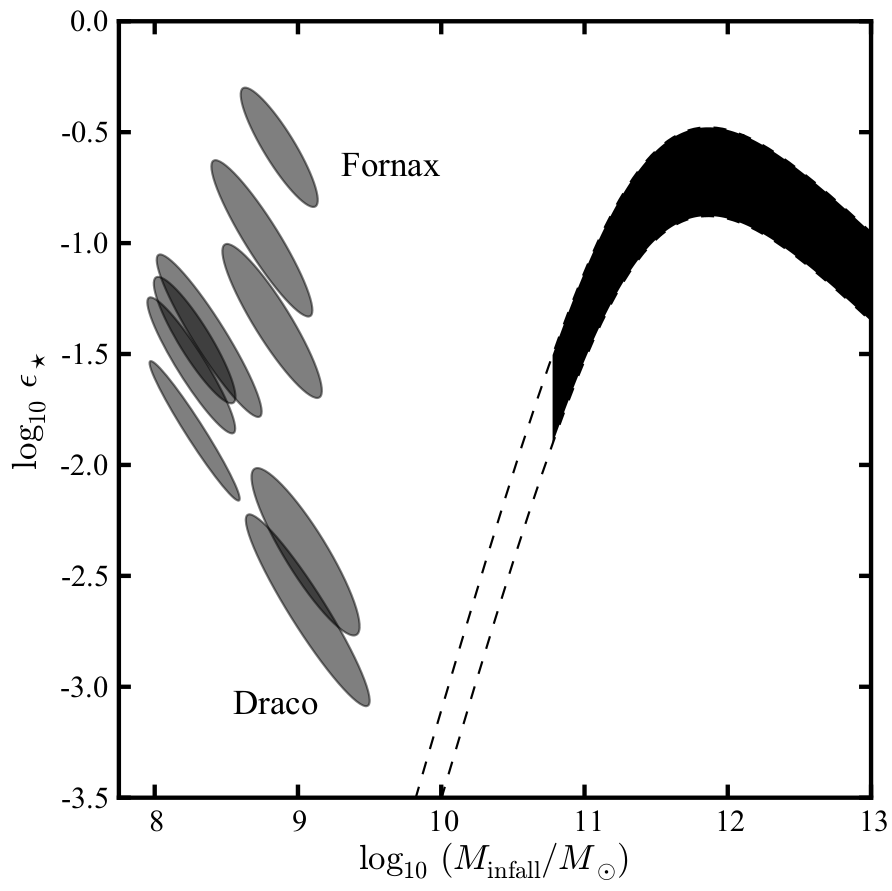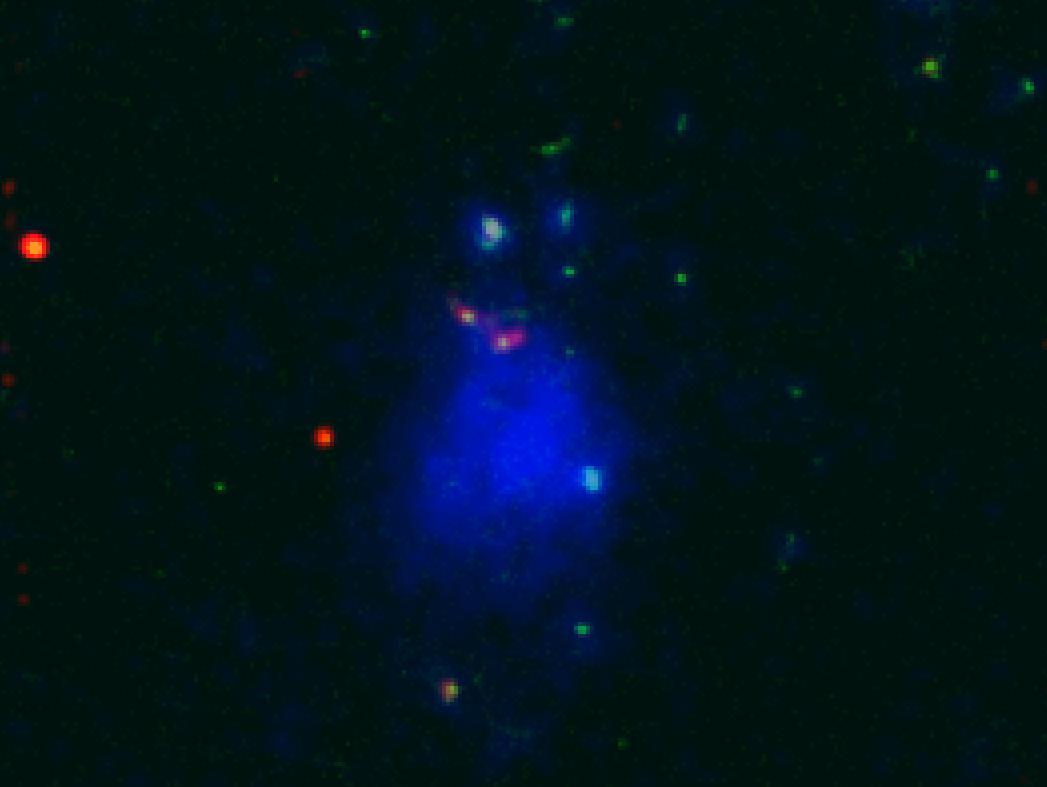
| Home | About | Science | People | Fellows Program | News | Calendar | Meetings |

The broad scientific aim of the CGE is to understand how galaxies emerged out of a nearly featureless early Universe into the rich variety of objects that we see forming the cosmic web today.
CGE members include world-leading experts in each of the major stages of cosmic evolution (left, from the big bang to the present day) and include observational, theoretical, and computational astrophysicists, as well as astronomical instrumentalists.
A list of recent CGE publications can be found here.Recent CGE Science Highlights

The Milky Way's bright satellites as an apparent failure of ΛCDM
M. Boylan-Kolchin, J. S. Bullock, M. Kaplinghat (2011) arXiv:1111.2048
The Milky Way hosts several satellite galaxies that appear to be among the most dark matter-dominated objects in the Universe. These systems provide a test of the standard cosmological model at a much smaller scale than is possible for most other observations. Surprisingly, a new analysis of the structure of these satellites has revealed that either galaxy formation is very different in these objects than in somewhat larger galaxies, or the ΛCDM model needs modification at these small scales. Left: The star formation efficiency of galaxies as a function of dark matter halo mass for bright galaxies in the Sloan Digitial Sky Survey (solid band) and for dwarf spheroidal galaxies in the Milky Way (ellipses). While massive galaxies are consistent with forming a star formation-halo mass sequence with relatively little scatter, the Milky Way satellites all are predicted to have similar masses with star formation efficiencies that vary by three orders of magnitude. Either galaxy formation is extremely stochastic at these masses, or the structure or abundance of dark matter subhalos predicted by ΛCDM does not match observations.
Related CGE papers:
Too Big to Fail? The Puzzing Darkness of Massive Milky Way Subhalos
M. Boylan-Kolchin, J. S. Bullock, M. Kaplinghat (2011) MNRAS, 415L, 40
Small Scale Structure in the SDSS and ΛCDM: Isolated ~L* Galaxies with Bright Satellites
E. Tollerud, M. Boylan-Kolchin, E. Barton, J. S. Bullock, C. Trinh (2011) ApJ, 738, 102
Metals Removed by Outflows from Milky Way Dwarf Spheroidal Galaxies
E. N. Kirby, C. L. Martin, K. Finlator (2011) ApJ, 742, 25
The Space Motion of Leo I: Hubble Space Telescope Proper Motion and Implied Orbit
T. S. Sohn, G. Besla, R. P. van der Marel, M. R. Boylan-Kolchin, S. R. Majewski, J. S. Bullock (2012) arXiv:1210.6039
The Space Motion of Leo I: The Mass of the Milky Way's Dark Matter Halo [Press Coverage]
M. R. Boylan-Kolchin, J. S. Bullock, T. S. Sohn, G. Besla, R. P. van der Marel (2012) arXiv:1210.6046
 The Lick AGN Monitoring Project 2011: Reverberation Mapping of Markarian 50
The Lick AGN Monitoring Project 2011: Reverberation Mapping of Markarian 50
A. J. Barth et al. (2011)
The Lick AGN Monitoring Project (LAMP) is a reverberation-mapping campaign with the primary goal of examining the structure and kinematics of broad-line regions in active galactic nulcei through measurement of velocity-resolved emission-line variability. Velocity-resolved reverberation is the most fundamental technique available to probe broad-line region structure and derive black hole masses in AGNs. These measurements are made by comparing the time-lag between the continuum and line emission, such as shown on the right on Arp 151 from Brewer et al. (2011). The LAMP spectroscopic observations are taken at the Lick 3-m Shane Telescope over the course of multi-month observing campaigns. Four and a half months of monitoring data for Mrk 50 were obtained in 2011; Barth et al. found strong continuum variability and a velocity-resolved response in the broad Hβ emission line, from which they obtained an estimate of about 30 million solar masses for the black hole mass.
CGE members include: Aaron Barth (Irvine; PI), Tommaso Treu (Santa Barbara), Matt Malkan (Los Angeles), Gabriela Canalizo (Riverside), Vardha Bennert (formerly Santa Barbara), Anna Pancoast (Santa Barbara); additional CGE participation from B. J. Brewer, M. C. Cooper, A. M. Diamond-Stanic, C. E. Harris, K. Hiner, S. Honig, M. Lazarova, A. M. Nierenberg, D. J. Sand, A. Sonnenfeld, S. Thorman, E. Tollerud, and J. L. Walsh
Related CGE papers:
The Lick AGN Monitoring Project: Velocity-delay Maps from the Maximum-entropy Method for Arp 151
M. C. Bentz, K. Horne, A. J. Barth, V. N. Bennert, G. Canalizo, A. V. Filippenko, E. L. Gates, M. A. Malkan, T. Minezaki, T. Treu, J.-H. Woo, J. L. Walsh (2010) ApJ, 720, 46
The Lick AGN Monitoring Project: Alternate Routes to a Broad-line Region Radius
J. E. Greene, C. E. Hood, A. J. Barth, V. N. Bennert, M. C. Bentz, A. V. Filippenko, E. Gates, M. A. Malkan, J. L. Walsh, T. Treu, J.-H. Woo (2010) ApJ, 723, 409
Geometric and Dynamical Models of Reverberation Mapping Data
A. Pancoast, B. J. Brewer, T. Treu (2011) ApJ, 730, 139
The Mass of the Black Hole in Arp 151 from Bayesian Modeling of Reverberation Mapping Data
B. J. Brewer, T. Treu, A. Pancoast, A. Barth, V. N. Bennert, M. C. Bentz, A. V. Filippenko, J. E. Greene, M. A. Malkan, J.-H. Woo (2011) ApJ, 733, 33
The Lick AGN Monitoring Project 2011: Dynamical Modeling of the Broad Line Region in Mrk 50
A. Pancoast, B. J. Brewer, T. Treu, A. Barth et al. (2012) ApJ, in press
 Using Lyman-α emission to learn about galaxy evolution
Using Lyman-α emission to learn about galaxy evolution
The bright hydrogen Lyman-α emission line can be traced across cosmic time to reveal vigorous star formation, accretion onto galaxies and supermassive black holes, and gas flowing out of galaxies.
Left: A false color image of a Lyman Alpha Blob at a redshift z=2.656. The Hydrogen Lyman alpha emission is shown in blue, and images in the optical V band and the near-infrared J+H bands are shown in green and red respectively. Notice the diffuse Lyman alpha emission and the many compact galaxies lying near the northern (top) end of the "blob". The Lyman alpha image was obtained using the SuprimeCam imaging camera on the Subaru Telescope, and the V, J, and H band images were obtained using the ACS and NICMOS cameras on the Hubble Space Telescope. This "blob" was originally discovered using observations with the Spitzer Space Telescope.
Picture credit: Dr. Moire Prescott (UCSB) and Dr. Arjun Dey (NOAO)
Related CGE papers:
Resolving the Galaxies within a Giant Lya Nebula: Witnessing the Formation of a Galaxy Group?
M. K. M. Prescott et al. (2011) arXiv:1111.0630
The Faint-End Slope of the Redshift 5.7 Lyman Alpha Luminosity Function
A. Henry, C. Martin, A. Dressler, M. Sawicki, P. McCarthy (2011) arXiv:1111.2354
Very Strong Emission-Line Galaxies in the WISP Survey and Implications for High-Redshift Galaxies
H. Atek, B. Siana, C. Scarlata, M. Malkan, P. McCarthy, H. Teplitz, A. Henry, J. Colbert, C. Bridge, A. J. Bunker, A. Dressler, R. Fosbury, N. P. Hathi, C. Martin, N. R. Ross, H. Shim (2011) arXiv:1109.0639
The Kinematics of Multiple-Peaked Ly-alpha Emission in Star-Forming Galaxies at z ~ 2-3
K. R. Kulas, A. E. Shapley, J. A. Kollmeier, Z. Zheng, C. Steidel, K. N. Hainline (2011)
Narrowband imaging of Escaping Lyman-Continuum Emission in the SSA22 Field
D. B. Nestor, A. E. Shapley, C. C. Steidel, B. Siana (2011) ApJ, 736, 18
The Rest-frame Ultraviolet Spectra of UV-selected Active Galactic Nuclei at z ~ 2-3
K. N. Hainline, A. E. Shapley J. E. Greene, C. C. Steidel (2011) ApJ, 733, 31
